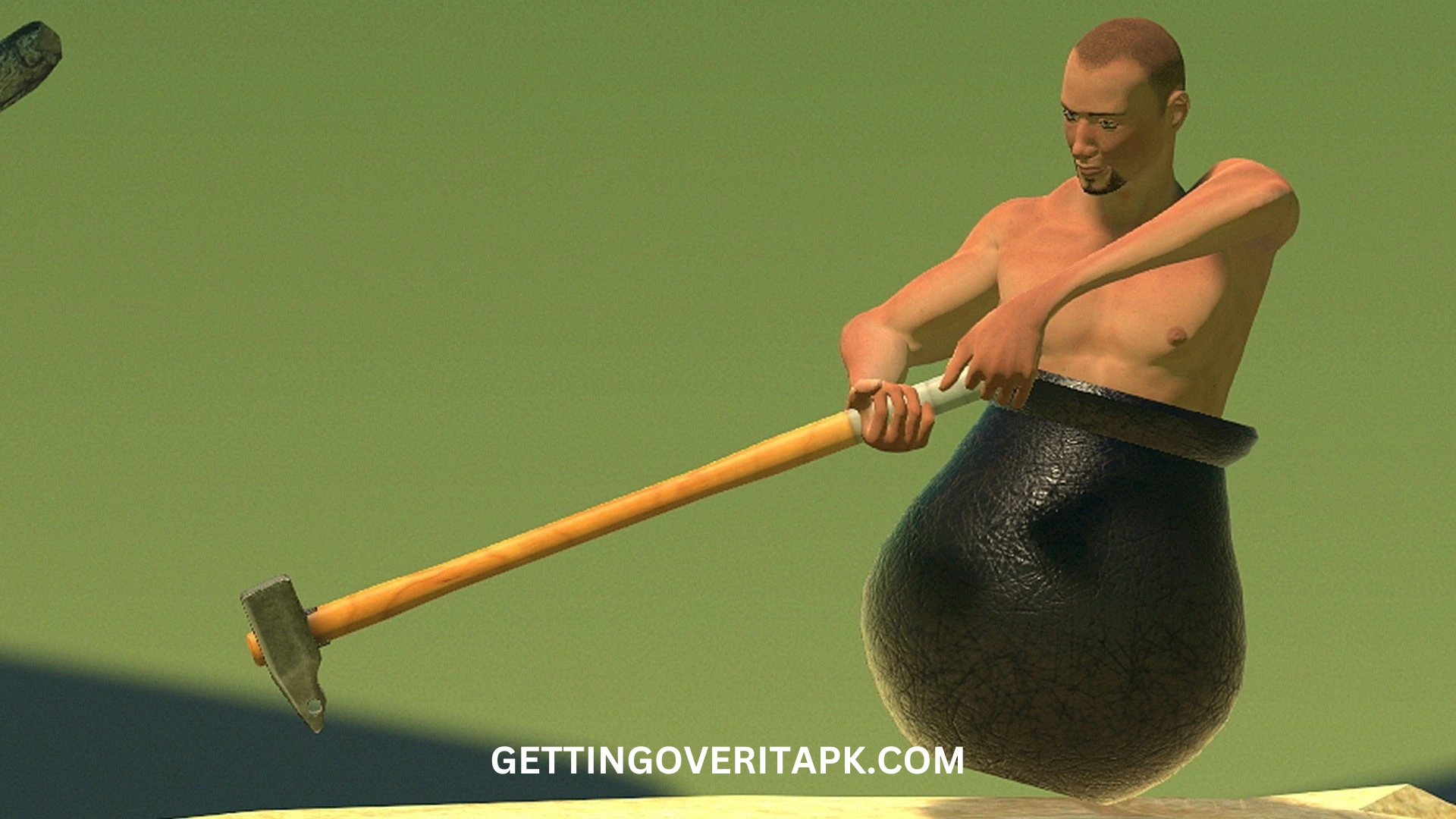What is the Story of Getting Over It Apk?
The story of Getting Over It apk isn’t told like most stories. In the game, you control a man named Diogenes, who sits in a big pot and has to climb a huge mountain made of random objects, using only a sledgehammer to help him move.
Even though the task seems simple, the real story is about the emotions and thoughts of facing tough challenges. As you climb, you hear the game’s creator, Bennett Foddy, talk about failure, persistence, and the frustration of losing progress. Every fall feels painful, but that’s where the real story lies; it’s about how you handle setbacks and keep going.
Gameplay
In terms of gameplay, Getting Over It is notoriously difficult. The controls are intentionally clunky, designed to make even simple movements feel like a Herculean task. One wrong move can send you tumbling back to the base of the mountain, losing hours of hard-earned progress.
Unlike most modern games, there are no checkpoints, save points, or ways to make the journey easier. This design choice amplifies the emotional stakes. Every inch of progress feels monumental, while every fall feels devastating. The game taps into a primal part of the human psyche, our desire to conquer challenges no matter how insurmountable they seem.
Real Meaning of Getting Over It
Getting Over It is more than just a challenging video game; it’s a metaphor for life. The mountain you climb represents the challenges we all face, challenges that don’t always have easy solutions and can push us to the brink of giving up. The real meaning of the game is about perseverance. It’s about how we cope when things don’t go our way, how we handle failure, and what it takes to keep going after a setback.
What Type of Game is Getting Over It?
Getting Over It with Bennett Foddy is a unique type of platformer known for its extreme difficulty and minimalist design. It falls under the genre of “physics-based” games, meaning that your character’s movements are dictated by the game’s physics engine. This creates a real-time sense of control, where every swing of the hammer needs precision and practice.
While other games in the genre might offer more polished mechanics or safety nets, Getting Over It is brutal in its simplicity. You must rely on your own skill and patience to climb the mountain. The game has no checkpoints, no power-ups, and no shortcuts. You’re forced to embrace its difficulty head-on, which makes it as much a mental challenge as it is a physical one.
Message Behind Game
The message behind Getting Over It can be summed up in one word: resilience. The game teaches you that failure isn’t just a possibility. Each time you fall, you have a choice: give up or keep trying. It’s a simple, yet powerful metaphor for life. We all encounter obstacles, setbacks, and failures, but pushing through them leads to growth.
Bennett Foddy’s voice-over throughout the game reinforces this message. He frequently reflects on how failure shapes us, how progress is often lost and regained, and how sometimes the struggle itself is the most meaningful part of the journey. The game encourages players to embrace frustration and learn from it rather than let it defeat them.
Bennett Foddy’s Philosophical Musings
What truly sets Getting Over It apart is the constant voiceover from Bennett Foddy. His soothing voice chimes in with philosophical reflections on the nature of frustration, failure, and the human condition as players repeatedly fall back down the mountain. These moments of reflection are not only engaging but also serve as insightful commentary on why we play games and how we handle adversity.
Foddy’s musings cover everything from historical quotes about perseverance to reflections on game design. His words often arrive at the perfect moment, when you’re on the verge of giving up, having fallen from a great height, reminding you that failure is part of the journey.
The Inspiration Behind Getting Over It
Foddy drew inspiration for Getting Over It from an old, obscure game called Sexy Hiking a 2002 B-game created by Jazzuo, which also involved climbing a mountain with a hammer. Sexy Hiking was known for its rough design and punishing difficulty, and Foddy wanted to recreate that sense of frustration while adding his philosophical spin.
Foddy has discussed how Getting Over It is designed to hurt a certain kind of person. He wanted to create an emotional experience where players would feel a genuine investment in their progress both the triumphs and the setbacks. The game’s minimalist design and unforgiving mechanics are intentional, pushing players to confront their frustrations and keep trying, no matter how many times they fall.
What is Special in Getting Over?
What makes Getting Over It stand out isn’t just its difficulty but the emotional journey it puts players through. Most games offer checkpoints, retries, or ways to ease frustration, but Getting Over It throws all of that out the window.
One wrong move can send you back down the mountain, erasing hours of progress. There are no second chances and no ways to save your game. This brutal design forces players to be fully present in each moment, knowing that a single mistake could undo everything.
Another special aspect is Bennett Foddy’s voice-over. Unlike other games, where the commentary might explain gameplay mechanics or storylines, Foddy’s dialogue in Getting Over It feels more like a personal conversation.
He talks about failure and frustration and even offers quotes from philosophers and writers about the human condition. It’s as if Foddy is sitting beside you, helping you make sense of the emotional rollercoaster the game creates.
No Jumpscare
Despite its punishing difficulty and tense moments, Getting Over It has no jumpscares. The game’s frustration comes from the constant risk of losing progress, not from sudden scares or creepy elements.
It’s not designed to frighten you but rather to push your patience to its limits.However, the emotional tension the game builds can sometimes feel just as intense as a horror game. When you’re teetering on the edge of a fall, the sense of dread is real, but it’s the kind of fear that comes from knowing your next mistake could set you back, not from anything popping out at you unexpectedly.
In short, Getting Over It challenges your mind and emotions, but it doesn’t use any cheap tricks like jumpscares. The fear it creates is rooted in your own progress or the potential to lose it.
Ending
Reaching the end of Getting Over It feels like a monumental achievement. After hours, maybe even days or weeks of climbing, falling and trying again, you finally reach the summit of the mountain.
But even the ending carries a sense of mystery. When you reach the top, the game asks if you are recording your playthrough. If you’re not, it gives you access to a hidden chatroom filled with other players who have completed the game.
This ending serves as both a reward and a reflection. It’s not about flashy cutscenes or in-game bonuses—it’s a quiet space where achievers who endured the same journey can come together. The journey is long and grueling, but the payoff is the sheer accomplishment of reaching the top.






